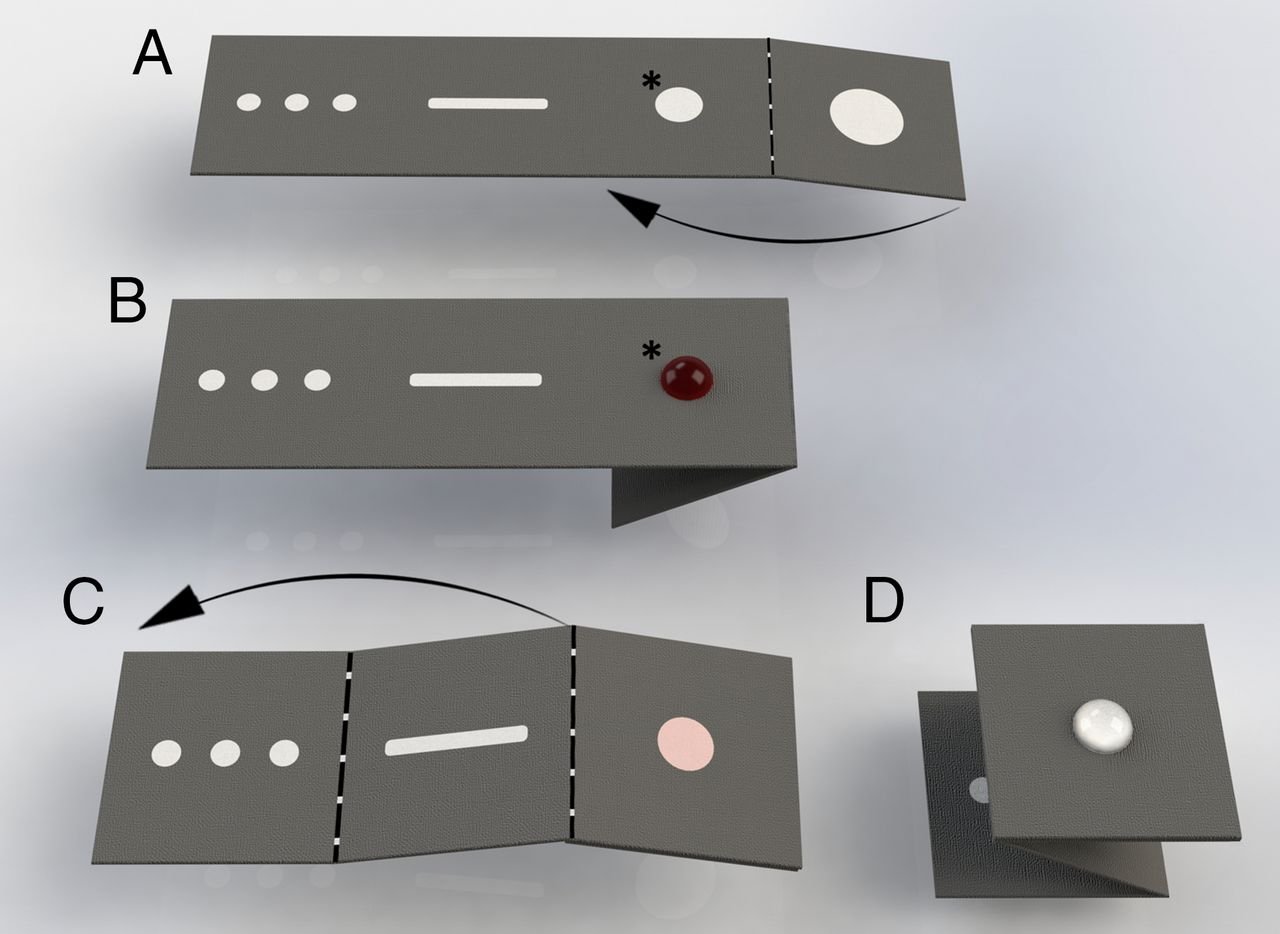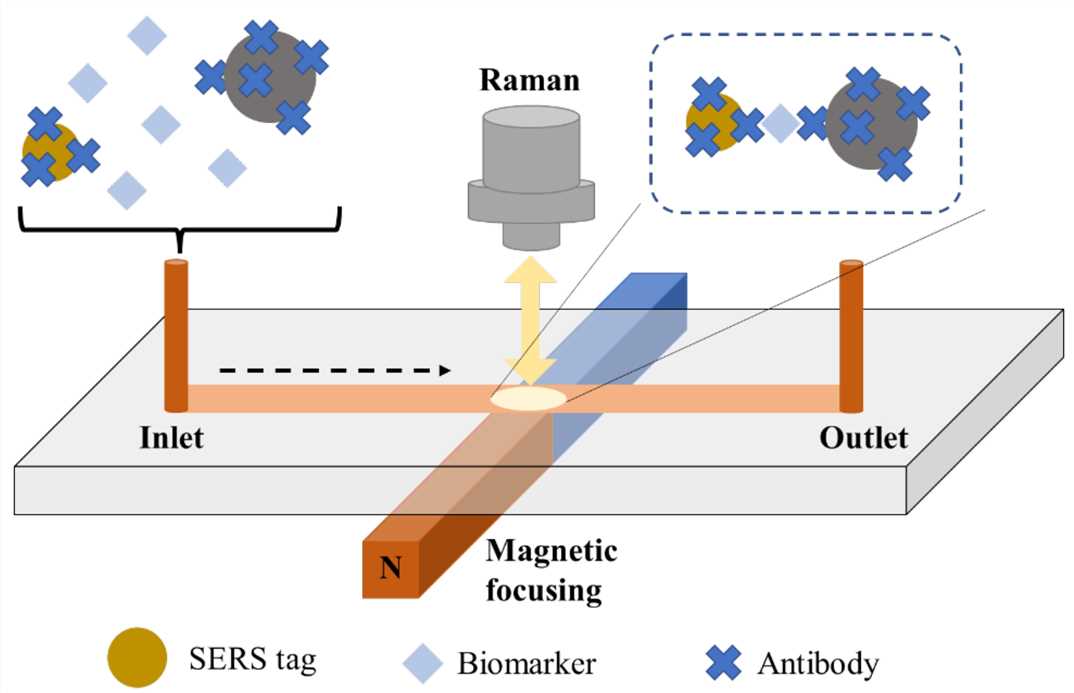Capable of automated, rapid, sensitive, and quantitative detection of biomarkers from patient samples, Microfluidic platforms could make a major impact on clinical or point-of-care testing (POCT). Chemiluminescence is a phenomenon of light generation due to chemical reaction, i.e. the conversion of chemical energy into light energy as electrons move from an excited state to a lower energy level. Various compounds react with hydrogen peroxide or oxygen, which results in the compound decomposing and light being emitted. Chemiluminescence detection has lots of advantages, such as a wide dynamic range, lower limits of detection and less-expensive instrumentation. Therefore, chemiluminescence has been proven to be a powerful analytical tool for Microfluidic platforms. Chemiluminescence immunoassay based Microfluidic platform is viable for POCT in a variety of clinical applications.
Chemiluminescence-based Microfluidic Platforms
- A three-dimensional (3D) Microfluidic paper-based immunodevice for the detection of cancer markers
A novel 3D Microfluidic paper-based immunodevice, integrated with blood plasma separation from whole blood samples, automation of rinse steps, and multiplexed chemiluminescence detections, was developed based on the principle of origami. Comprised of one test pad surrounded by four folding tabs, this origami-based device could be patterned and fabricated by wax-printing on paper in bulk. Moreover, a sandwich-type chemiluminescence immunoassay was introduced into this immunodevice. Four cancer markers, including r-fetoprotein (AFP), carcinoma antigen 153 (CA153), carcinoma antigen 199 (CA199), and carcinoembryonic antigen (CEA) in whole blood samples were simultaneously detected in a single analytical run. This paper-based Microfluidic origami chemiluminescence detection system provides a new strategy for a low-cost, sensitive, simultaneous multiplex immunoassay and point-of-care diagnostics.
 Fig.1 Paper-folding steps for fluidic manipulation.1, 3
Fig.1 Paper-folding steps for fluidic manipulation.1, 3
- A Microfluidic chemiluminescent immune sensor for the detection of C-reactive protein (CRP) and testosterone
A fully integrated Microfluidic chemiluminescent immune sensor was reported for automated and quantitative detection of biomarkers, such as CRP and testosterone in clinical serum samples. This device is composed of two main components: 1) a disposable, integrated and self-contained Microfluidic chip, and 2) a portable instrument. It can be carried out completely automated operations. The assembled three-layered chip with on-chip mechanical valves for fluid control consists of 1) a top silicone fluidic layer with embedded zigzag microchannels, reagent reservoirs and the negative pressure port, 2) a middle tinfoil layer with patterned antibodies/antigens stripes, and 3) a bottom silicone substrate layer with waste reservoirs. The versatility of this system is demonstrated by the implementation of chemiluminescent immunoassay for quantitative detection for CRP and testosterone. The chemiluminescent signals are acquired and processed inside the instrument. This device shows features of quantitation, portability and automation that might be impactful in diagnostic fields.
 Fig.2 Schematic microfluidic system integrated with surface-enhanced Raman spectroscopy for biomarker detection.2, 3
Fig.2 Schematic microfluidic system integrated with surface-enhanced Raman spectroscopy for biomarker detection.2, 3
- A bead-based Microfluidic system for the detection of viruses
TORCH is a classical group of five teratogenic pathogens including Toxoplasmosis (TOX), Rubella virus (RUB), Cytomegalovirus (CMV), and Herpes simplex virus type 1 and 2 (HSV-1, HSV-2). TORCH screening to pregnant women is helpful to provide critical clinical information for antenatal care. Scientists have fabricated a device using a multi-step chemiluminescence assay to detect TORCH. Microbeads were immobilized with one type of antigen and were magnetically guided from one chamber to the next. The use of different antigens enabled the screening of five infections simultaneously. Moreover, this method had improved sensitivity, making this a potential candidate for future infection screenings.
- An integrated Microfluidic system for rapid enumeration of CD4+ T lymphocytes
A rapid, simple, convenient and easy-to-use CD4+ T lymphocyte enumeration method based on a Microfluidic system with a single bead in POCT was reported. This Microfluidic system is developed to facilitate CD4+ T lymphocyte enumeration without the need of active pumping. Chemiluminescence assay is adopted for CD4+ T lymphocyte enumeration because of low background with the detection signal. CD4+ T lymphocyte enumeration with the developed Microfluidic system is achieved by analyzing the chemiluminescence signal intensity of the single bead collected by a CCD camera, and its performance is validated with different testing samples. The incubation time is significantly reduced because of the introduced mixing with the outside magnetic control to the single bead. Moreover, CD4+ T lymphocyte enumeration can be finished within just 45 min, which is beneficial to POCT.
References
- Reboud, Julien, et al. "based microfluidics for DNA diagnostics of malaria in low resource underserved rural communities." Proceedings of the National Academy of Sciences 116.11 (2019): 4834-4842.
- Pollap, Aleksandra, and Paweł Świt. "Recent advances in sandwich sers immunosensors for cancer detection." International Journal of Molecular Sciences 23.9 (2022): 4740.
- Distributed under Open Access license CC BY 4.0, without modification.
For Research Use Only.

